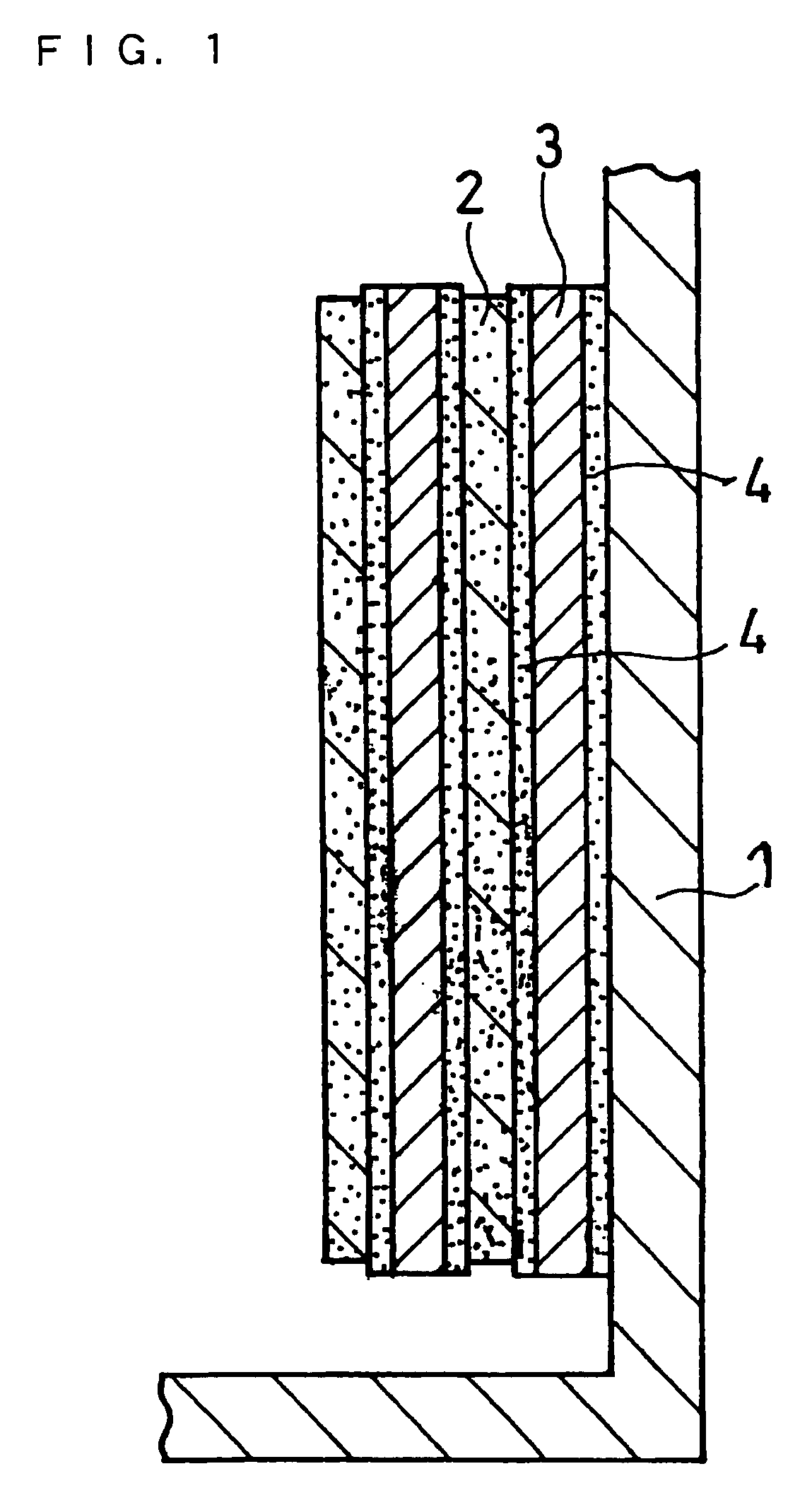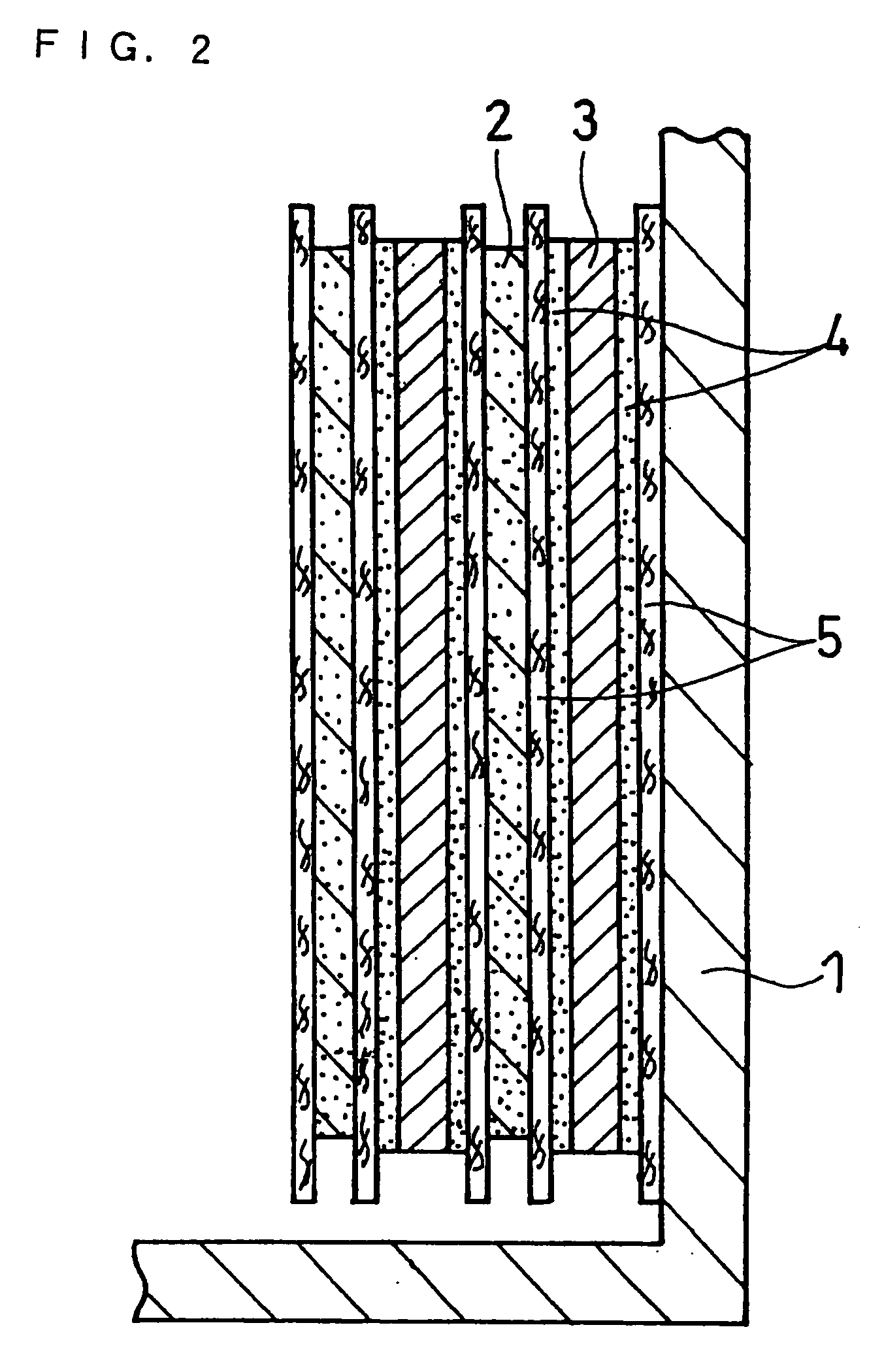Non-Aqueous Electrolyte Secondary Battery
a secondary battery and non-aqueous electrolyte technology, applied in the direction of cell components, sustainable manufacturing/processing, cell components, etc., can solve the problems of easy expansion of short-circuit portion by melting, large battery capacity consumed, etc., to improve the output characteristics of the battery, prevent winding displacement of the electrode assembly, and excellent vibration resistance
- Summary
- Abstract
- Description
- Claims
- Application Information
AI Technical Summary
Benefits of technology
Problems solved by technology
Method used
Image
Examples
example 1
Battery 1
(Fabrication of a Positive Electrode)
[0075]A positive electrode active material mixture paste was prepared by stirring with a double arm kneader 30 kg of LiNi0.71Co0.2Al0.05Mn0.02Mg0.02O2 as a positive electrode active material, 10 kg of N-methyl-2-pyrrolidone (NMP) solution available from Kureha Chemical Industry Co., Ltd. (solid content: 12% by weight)) of polyvinylidene fluoride (PVDF), 900 g of acetylene black as a conductive agent and an appropriate amount of NMP. The paste was applied onto both faces of an aluminum foil (thickness: 15 μm) as a current collector, then dried and rolled until the total thickness reached 108 μm, whereby a positive electrode plate was obtained. Subsequently, the positive electrode plate was cut so that the dimensions of the positive electrode active material layer per one face of the current collector were a width of 56 mm and a length of 600 mm to yield a positive electrode. The area of the active material layer per one face of the positi...
example 2
Batteries 12 to 35
[0106]Batteries 12 to 35 were fabricated in the same manner as Battery 2 except that a positive electrode active material represented by the formula (1): LiNi1-a-b-c-dCoaAlbM1cM2dO2 was used and the elements as shown in Table 3 were used as M1 and M2, and the molar ratios of Ni, Co, Al, M1 and M2 were changed as shown in Table 3. Herein, M2 contains two to four types of elements. The molar ratio of each elements contained in M2 was the same. The molar ratio d is a total molar ratio of the elements of M2 in the oxide represented by the formula (1).
TABLE 3LiNi1-a-b-c-dCOaAlbM1cM2dO2MolarMolarMolarMolarMolarratio aratio bratio cratio dratioof Coof Alof M1Type of M1of M2Type of M2of NiBattery 20.20.050.025Mn0.025Mg + Ca0.70Battery 120.0450.050.025Mn0.025Mg + Ca0.86Battery 130.050.050.025Mn0.025Mg + Ca0.85Battery 140.350.050.025Mn0.025Mg + Ca0.55Battery 150.40.050.025Mn0.025Mg + Ca0.50Battery 160.20.0040.025Mn0.025Mg + Ca0.75Battery 170.20.0050.025Mn0.025Mg + Ca0.75Batt...
example 3
Batteries 36 to 64
[0116]Batteries 36 to 64 were fabricated in the same manner as Battery 2 except that a positive electrode active material represented by the formula (2): LiNiaCobMncM3dO2 was used and the molar ratio a of nickel, the molar ratio b of cobalt, the molar ratio c of manganese and the type and the molar ratio d of element M3 were changed as shown in Table 5.
TABLE 5LiNiaCObMncM3dO2MolarMolarMolarMolarratio a of Niratio b of Coratio c of MnType of M3ratio d of M3Battery 360.20.40.4——Battery 370.250.3750.375——Battery 380.50.250.25——Battery 390.550.2250.225——Battery 400.40.20.4——Battery 410.3750.250.375——Battery 420.250.50.25——Battery 430.2250.550.225——Battery 440.40.40.2——Battery 450.3750.3750.25——Battery 460.250.250.5——Battery 470.2250.2250.55——Battery 480.3170.3170.317Mg0.05Battery 490.30.30.3Mg0.1Battery 500.2830.2830.283Mg0.15Battery 510.3170.3170.317Ti0.05Battery 520.3170.3170.317Ca0.05Battery 530.3170.3170.317Sr0.05Battery 540.3170.3170.317Zr0.05Battery 550.3750.20.3...
PUM
| Property | Measurement | Unit |
|---|---|---|
| heat resistant | aaaaa | aaaaa |
| heat resistance | aaaaa | aaaaa |
| energy density | aaaaa | aaaaa |
Abstract
Description
Claims
Application Information
 Login to View More
Login to View More - R&D
- Intellectual Property
- Life Sciences
- Materials
- Tech Scout
- Unparalleled Data Quality
- Higher Quality Content
- 60% Fewer Hallucinations
Browse by: Latest US Patents, China's latest patents, Technical Efficacy Thesaurus, Application Domain, Technology Topic, Popular Technical Reports.
© 2025 PatSnap. All rights reserved.Legal|Privacy policy|Modern Slavery Act Transparency Statement|Sitemap|About US| Contact US: help@patsnap.com



